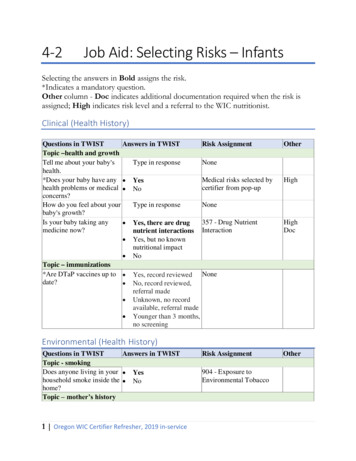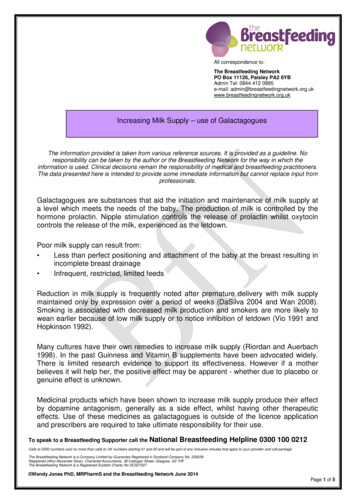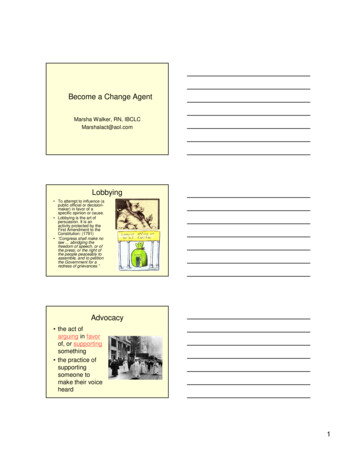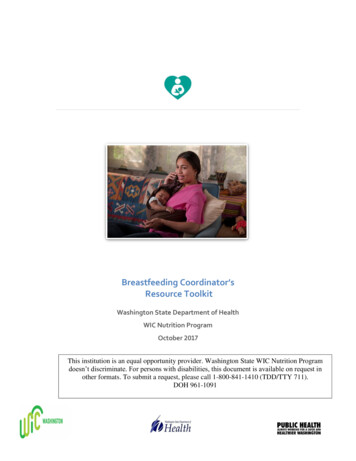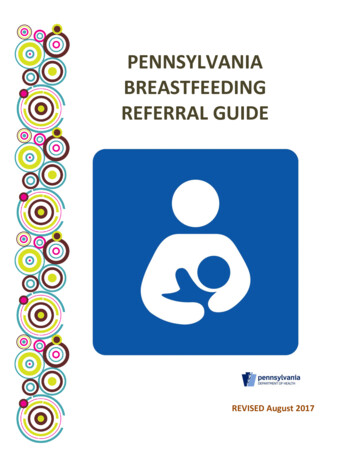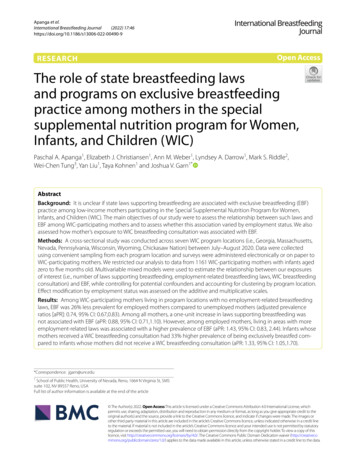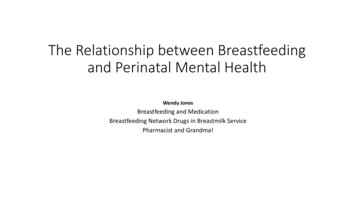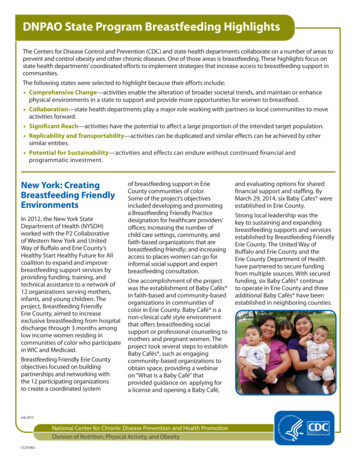
Transcription
DNPAO State Program Breastfeeding HighlightsThe Centers for Disease Control and Prevention (CDC) and state health departments collaborate on a number of areas toprevent and control obesity and other chronic diseases. One of those areas is breastfeeding. These highlights focus onstate health departments’ coordinated efforts to implement strategies that increase access to breastfeeding support incommunities.The following states were selected to highlight because their efforts include: Comprehensive Change—activities enable the alteration of broader societal trends, and maintain or enhancephysical environments in a state to support and provide more opportunities for women to breastfeed. Collaboration—state health departments play a major role working with partners or local communities to moveactivities forward. Significant Reach—activities have the potential to affect a large proportion of the intended target population. Replicability and Transportability—activities can be duplicated and similar effects can be achieved by othersimilar entities. Potential for Sustainability—activities and effects can endure without continued financial andprogrammatic investment.New York: CreatingBreastfeeding FriendlyEnvironmentsIn 2012, the New York StateDepartment of Health (NYSDH)worked with the P2 Collaborativeof Western New York and UnitedWay of Buffalo and Erie County’sHealthy Start Healthy Future for Allcoalition to expand and improvebreastfeeding support services byproviding funding, training, andtechnical assistance to a network of12 organizations serving mothers,infants, and young children. Theproject, Breastfeeding FriendlyErie County, aimed to increaseexclusive breastfeeding from hospitaldischarge through 3 months amonglow income women residing incommunities of color who participatein WIC and Medicaid.Breastfeeding Friendly Erie Countyobjectives focused on buildingpartnerships and networking withthe 12 participating organizationsto create a coordinated systemof breastfeeding support in ErieCounty communities of color.Some of the project’s objectivesincluded developing and promotinga Breastfeeding Friendly Practicedesignation for healthcare providers’offices; increasing the number ofchild care settings, community, andfaith-based organizations that arebreastfeeding friendly; and increasingaccess to places women can go forinformal social support and expertbreastfeeding consultation.One accomplishment of the projectwas the establishment of Baby Cafés in faith-based and community-basedorganizations in communities ofcolor in Erie County. Baby Café is anon-clinical café style environmentthat offers breastfeeding socialsupport or professional counseling tomothers and pregnant women. Theproject took several steps to establishBaby Cafés , such as engagingcommunity-based organizations toobtain space, providing a webinaron “What is a Baby Café” thatprovided guidance on applying fora license and opening a Baby Café,July 2015National Center for Chronic Disease Prevention and Health PromotionDivision of Nutrition, Physical Activity, and ObesityCS257863and evaluating options for sharedfinancial support and staffing. ByMarch 29, 2014, six Baby Cafes wereestablished in Erie County.Strong local leadership was thekey to sustaining and expandingbreastfeeding supports and servicesestablished by Breastfeeding FriendlyErie County. The United Way ofBuffalo and Erie County and theErie County Department of Healthhave partnered to secure fundingfrom multiple sources. With securedfunding, six Baby Cafés continueto operate in Erie County and threeadditional Baby Cafés have beenestablished in neighboring counties.
California: Building aContinuum of Care forBreastfeedingThe California Department of PublicHealth (CDPH) has made significantefforts to increase breastfeedingrates in California’s underservedcommunities by enhancing careat community clinics. In 2012, theCDPH developed the BreastfeedingSupport in California CommunityClinics statewide pilot project tobuild a better “Continuum of Care”for breastfeeding moms. To providehigh-quality, culturally competentbreastfeeding promotion, supportand care services during theperinatal period, CDPH workedcollaboratively with the Women,Infants, and Children Division, theMaternal, Child and AdolescentHealth Division, the California WICAssociation (CWA), and the CaliforniaBreastfeeding Coalition(CBC) onthe pilot project. CDPH selectedand funded 15 community healthclinic organizations to plan andimplement environmental andprocedural changes to improvesupport for breastfeeding womenand their infants.As part of the project, CDPH, CWA,and CBC formed an expert panelthat guided the development ofthe draft Nine Steps to BreastfeedingFriendly Guidelines and EvaluationCriteria for Community HealthCenters and Outpatient Care Settingsdocument. The Nine Steps werecreated in a similar fashion as the TenSteps for Successful Breastfeeding1designation for hospitals andbirthing facilities to provide guidancefor clinics and physicians’ offices onreimbursement of lactation servicesand on providing an environmentthat is breastfeeding friendly. Afterthe project period, CDPH wasable to leverage additional CDCbreastfeeding funds to continuedeveloping and implementing atoolkit for implementation of theNine Steps.CDPH is continuing to work with theinitial 15 community health clinics,which primarily serve low-income,women of color in 11 countiesthroughout the state and representa diverse group of clinics, fromfederally qualified health centersto private clinics. All 15 communityhealth clinics have implementedsteps from the Nine Steps and serveas a model for other clinics workingto improve breastfeeding practices.CDPH is in the process of releasingthe final Nine Steps document anddistributing it electronically to clinicsand health centers across California.Baby-Friendly USA. The Ten Steps to Successful Breastfeeding website. dly-hospital-initiative/the-ten-steps.Accessed June 8, 2015.1Indiana: Takingthe Initiative forBreastfeeding SupportThe Indiana State Departmentof Health’s (ISDH) Division ofNutrition, Physical Activity andObesity partnered with the IndianaPerinatal Network, the IndianaBreastfeeding Coalition, and theState Breastfeeding Coordinatorto develop and implement theCommunity Breastfeeding SupportInitiative (CBSI). ISDH and partnersprovided funding and technicalsupport to community-basedorganizations (CBOs) to addressbarriers that breastfeeding mothersencounter and increase support forbreastfeeding initiation and duration,especially for women of color. UnderCBSI, 13 CBOs were funded andprovided training throughout theproject period.Each CBO worked independentlyto expand existing breastfeedingJuly 2015support in their respectivecommunities, outlining specificbreastfeeding goals and relaying datato CBSI program staff. For example,Well Babies at Walgreens, a programthat offers breastfeeding drop-inservices such as consultation, weightchecks, peer support, and equipmentrental, was able to expand existingbreastfeeding support under CBSI.Well Babies expanded services toan additional Walgreens location,offered prenatal breastfeedingclasses, trained pharmacists inlactation support, and offeredbreastfeeding reference material tomore than 70 Walgreens locationsand 15 nurse practitioner clinics incentral Indiana.Page 2 of 5
All but one of the 13 communitybased organizations (CBOs) havebeen able to sustain or expandactivities supported by CBSI.They have done so throughleveraging additional fundingfrom organizations such asMinority Health Coalition andlocal hospital Community Benefitgrant dollars or establishingstrategic partnerships. In somecases, breastfeeding support wasadded to a job description or asa line item in a hospital’s budget.Massachusetts: ItTakes a Community toSupport BreastfeedingIn 2012, the MassachusettsDepartment of Public Health(MDPH) partnered with WIC andMass in Motion (Massachusetts’sobesity prevention initiative) toimprove breastfeeding support andcare for Massachusetts mothersthrough community-based postdischarge resources for womenand their families. MDPH providedfunding to communities alreadyinvolved with Mass in Motion (MiM)and required new or establishedprograms to coordinate with localWIC programs. Communities fundedby MDPH developed individualizedimplementation plans and providededucation, peer mentoring, accessto post-discharge care, and othersupportive services to breastfeedingmothers in their communities. Intotal, grants were awarded to sixBreastfeeding Continuity of CareTeams (BCCTs) and three Baby Cafés .Each BCCT was led by a nonprofitcommunity-based organization(CBO) and made up of at least threeparticipating CBOs.Each BCCT made considerableachievements during the fundingperiod. For example, the BerkshireJuly 2015For example, in February 2015, WellBabies at Walgreens partnered witha neighboring hospital system tohelp staff a Well Babies locationwith lactation professionals fromthe hospital.In addition to the CommunityBreastfeeding Support Initiative, thestate breastfeeding coordinator, theIndiana Breastfeeding Coalition (IBC),the Indiana Perinatal Network (IPN)and Indiana’s Division of Nutrition,Physical Activity and Obesity (DNPA)supported several breastfeedingrelated events in 2014, such as the 5thAnnual Perinatal Hospital Summit.The Perinatal Hospital Summitbrought together high-level clinicaland administrative leaders from allof Indiana’s delivering hospitals. Intotal, 230 people attended, and 91of Indiana’s 94 delivering hospitalswere represented. Events such as thissummit provided opportunities forIBC, IPN, DNPA, the state breastfeedingcoordinator, and the 13 CBOs tomaintain and continue relationshipsbuilt during the grant period.BCCT, which was made up of a totalof seven CBOs, provided greaterbreastfeeding support to womenserved by CBOs on the team. Onemother who attended BerkshireNursing Families, the lead CBOin the Berkshire BCCT said, “Justwhen you’re wondering why thebaby is feeding constantly or whyshe no longer wants to nurse onone side, someone from NursingFamilies calls and asks how thingsare going. I’ve really appreciated allthe support This kind of continual,warm, non-judgmental support isvery, very special.”Several of the communities thatreceived funding have managedto sustain their programs. Forexample, Mercy Hospital and theLynn Community Health Center, twoBCCTs funded by MDPH, continueoperating their Baby Cafés tooffer breastfeeding support andprofessional counseling to mothersand pregnant women. MDPH alsocontinues to provide technicalassistance and share potentialgrant opportunities to BCCTs.Program activities have also led tocollaborations between local birthhospitals, WIC programs and otherPage 3 of 5
community partnerships, such asMass in Motion. Moreover, MDPH’spartnership with NortheasternUniversity helped leverage skilledpersonnel by subcontractinggraduate students for data collectionand evaluation of the BCCTs. Strongpartnerships and experience haveprovided MDPH with a betterunderstanding of what breastfeedingsupport systems communities need.MDPH has now expanded its rolein breastfeeding support fromcommunity-based organizations toclinics and hospitals. Through CDCfunds, MDPH developed tools andtrainings for breastfeeding supportfor professional communities,such as the online breastfeedingtutorial, Expanding Clinicians’ Rolesin Breastfeeding Support: Focus onMaternal and Infant Care Prenatallyand During the Hospital Stay. ThisMichigan: EnhancingCommunityBreastfeeding SupportThe Michigan Department ofCommunity Health’s (MDCH)Nutrition, Physical Activity, andObesity Prevention Program hasJuly 2015tutorial complements MDPH’s firsttutorial, Expanding Clinicians’ Rolesin Breastfeeding Support: ContinuingMedical Education. Together, thetrainings accommodated the 3-hourtraining time component required bythe Baby-Friendly Hospital Initiative for physicians. As of March 31, 2015,3,323 providers (physicians andnurses) have completed the course.worked to build capacity withincommunity-based agencies,organizations, public healthprograms, and private entitiesto assist breastfeeding womenin successfully meeting theirbreastfeeding goals. Through severalstrategies, including trainings,community-based peer supportservices, and the developmentand dissemination of resources,MDCH has improved efforts toaddress breastfeeding barriers andimprove breastfeeding support atthe community and state levels. Forexample, in 2012, MCDH partneredwith nine local BreastfeedingCoalitions in Michigan to enhancepost-hospital discharge support forbreastfeeding mothers to encourageexclusive breastfeeding and extendbreastfeeding duration throughthe first 6-12 months of the infant’slife. Support was primarily providedthrough breastfeeding supportgroups, where mothers receivedadvice from International BoardCertified Lactation Consultants(IBCLC) and peer counselors ontopics such as returning to work,latching, and milk production.A mother at a Jackson Countysupport group stated, “It is greatthat we are able to come hereand talk with mothers. I am alsoappreciative of the fact that anIBCLC was able to assist me whenI had an issue.” Some participantsindicated barriers, such as lack oftransportation. As a solution, thesupport groups sought to “meetmoms where they are at,” such ashosting meetings at convenientlocations for mothers (e.g., thelibrary). Successful strategies of thesupport groups included: providingincentives to program participants,hosting meetings at convenientplaces, and reaching out to newmoms through current participantsand social networking sites.Through strong partnerships,providing technical assistanceand training, and generatingcommunity awareness, MDCFcontinues to provide supportfor breastfeeding womenPage 4 of 5
to successfully meet theirbreastfeeding goals. For example,MDCH’s partner organization,the Black Mothers’ BreastfeedingAssociation, continues to convenethe Black Mothers’ BreastfeedingClub to provide a breastfeedingsupport group. The Black Mothers’Breastfeeding Club is a freemother-led breastfeeding supportgroup that meets monthly in acommunity setting. Pregnantand breastfeeding motherscome together for fellowshipand breastfeeding support. Inaddition, MDCH works to promotebreastfeeding support in licensedEarly Childhood Education centers.Out of the 18 licensed childcare providers that developedor adopted nutrition-relatedpolicies according to expertrecommended guidelines, sixincluded breastfeeding support as apriority in their action plans, and fiveof those developed breastfeedingsupport policies.For more information, go to:http://www.cdc.gov/breastfeedingJuly 2015Page 5 of 5
the Indiana Perinatal Network (IPN) and Indiana's Division of Nutrition, Physical Activity and Obesity (DNPA) supported several breastfeeding . Massachusetts: It Takes a Community to Support Breastfeeding. In 2012, the Massachusetts Department of Public Health (MDPH) partnered with WIC and Mass in Motion (Massachusetts's
